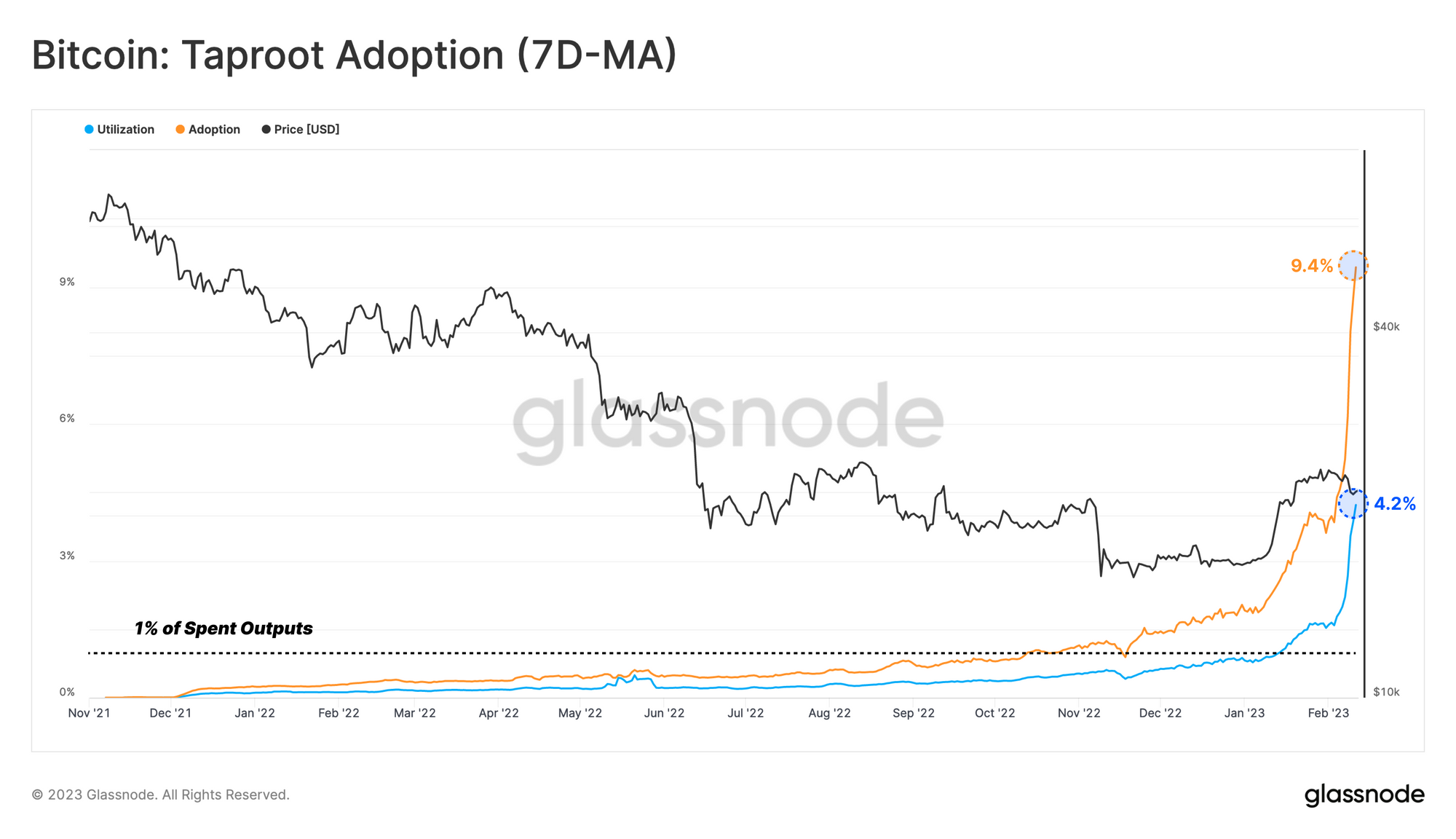[ad_1]
Data reveals that Bitcoin taproot utilization has now hit a brand new all-time excessive, due to the emergence of Ordinals on the community.
Bitcoin Taproot Utilization Hits New All-Time High Of 4.2%
According to the newest weekly report from Glassnode, each Taproot adoption and utilization have hit all-time highs lately. “Taproot” is a BTC improve that launched some adjustments to how transactions are processed, to make them sooner and extra environment friendly. The improve went live again within the November of 2021.
The “Taproot adoption” here’s a metric that tells us how a lot adoption the improve has seen amongst customers on the community. The indicator is impressed by the one the group got here up with for monitoring SegWit adoption (SegWit being one other BTC protocol that went reside again in 2017).
Like the SegWit adoption, the Taproot adoption quantifies adoption based mostly on the share of the whole Bitcoin transactions which have not less than one Taproot enter concerned in them.
This methodology, nevertheless, has a serious flaw. Glassnode’s report on SegWit adoption from final yr summed up the issue utilizing the instance within the under determine:

Three examples of BTC transactions | Source: Glassnode
In this instance, the middle transaction concerned one SegWit enter (and 4 legacy ones), whereas the correct one had 5 SegWit inputs. Since the SegWit adoption indicator solely cares about what number of transfers embody not less than one such enter, each middle and proper transactions can be thought of SegWit ones.
Because two-thirds of the transfers listed here are SegWit in keeping with the indicator, the adoption can be valued at 66%. However, clearly, this isn’t an correct illustration of the particular utilization of the protocol, because the indicator ignores the finer particulars of the transactions.
To remedy the problem, Glassnode got here up with the “utilization” metric, which really counts all of the spent outputs concerned in a switch and calculates the worth based mostly on their complete. If this new indicator is utilized to the above instance, the utilization would come out to be 40% as solely 6 out of the 15 inputs listed here are made utilizing SegWit-ready software program.
Coming again to Taproot, this similar methodology may also be utilized to guage the acceptance of this Bitcoin improve. Below is a chart that reveals the development within the 7-day transferring common (MA) Taproot adoption, in addition to the utilization, because the improve went reside again in November 2021:

The 7-day MA values of each the metrics appear to have shot up lately | Source: Glassnode's The Week Onchain - Week 7, 2022
As displayed within the above graph, each the 7-day MA Bitcoin taproot adoption and utilization have quickly gone up lately and hit new all-time highs of 9.4% and 4.2%, respectively. The adoption right here is greater than double the utilization, additional displaying how deceptive the image introduced by the previous indicator might be.
The purpose behind this sudden surge in Taproot utilization is the rise of Ordinals out there. Ordinals is a protocol that makes use of Taproot to inscribe information into the witness portion of a BTC transaction.
In easy phrases, what Ordinals permits a person to do is to connect issues like photos to BTC transactions, one thing that has led to the onset of non-fungible tokens (NFTs) on the blockchain. As these NFTs have been rapidly gaining popularity, it’s no shock that Taproot has additionally been observing considerably extra use.
BTC Price
At the time of writing, Bitcoin is buying and selling round $21,800, down 5% within the final week.

BTC continues to maneuver sideways | Source: BTCUSD on TradingView
Featured picture from Dmitry Demidko on Unsplash.com, charts from TradingView.com, Glassnode.com
[ad_2]
Source link



